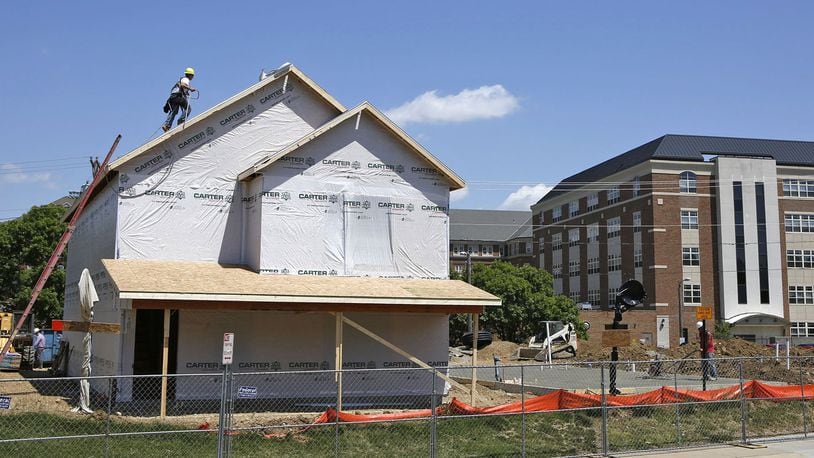Keyes said the project calls for:
• Demolishing the existing 90-year-old McGinnis Center in the student neighborhood and replacing it with a $6 million multi-use facility that will provide housing for 96 students. The ground floor of the four-story building will include large meeting rooms and office space to fill the community-center role that the McGinnis Center serves, Keyes said. Construction is expected to begin next year.
• Building eight five-bedroom, three-bath houses on empty lots in the 400 block of Stonemill Street, adjacent to campus. Construction has begun on the first of those houses at 405 Stonemill St.
• Razing one small home and building 10 new townhouses on multiple lots on Kiefaber Street. Rather than face the street, the five-person homes will cluster around open space, creating a mini-neighborhood, Keyes said. Construction is scheduled to begin next summer. The Kiefaber and Stonemill projects together will cost an estimated $5 million.
• Spending $6 million to renovate five buildings of the Garden Apartments located in the 300 block of East Stewart Street. The renovations are already underway and will include new kitchens and bathrooms this summer, with exterior and other work to be completed next summer.
The projects will add about 200 beds to the campus neighborhood by August 2017, Keyes said.
The university has purchased many of the houses in the neighborhood over the past 20 years, and now owns about 90 percent of the residential properties east of Brown Street and adjacent to campus. Private landlords own the remaining 10 percent of properties, and UD officials “are always in discussions” with those property owners about selling their rental units to UD, Keyes said.
The off-campus student neighborhood is a distinctive and powerful recruiting tool for UD, whose students learn to live and flourish in a residential community, Keyes said. “Many students will tell you it’s the greatest experience they had at UD,” she said.
And university officials are working to provide amenities in the off-campus housing that boost students’ quality of life — and to protect them from harm. Keyes said the new houses will come equipped with washer and dryer, dishwasher, microwave and garbage disposal. Safety features include fire-suppression systems, fire alarms and carbon monoxide detectors.
And the new homes will be easy on the environment, with energy-efficient furnaces and appliances, tankless water heaters and energy-efficient windows, UD officials said.
The UD project is good news for local building trades and the construction industry. John Popelar, director of special programs for the Greater Dayton Construction group, said the UD project will create, or protect from layoff, about 70 jobs among his company and his company’s subcontractor trade partners. Greater Dayton Construction is serving as the general contractor and construction manager for the Stonemill Street new construction and the Garden Apartment renovation projects.
The student-neighborhood improvements follow a decade-long renovation project that “touched every room” of the university’s residence halls, replacing bathrooms, windows and heating-and-cooling systems and updating food-service facilities, Keyes said. UD officials said its investments in student housing during the last decade have exceeded $150 million. Marycrest, Stuart, Virginia W. Kettering, Founders and Campus South residence halls have undergone major renovations, and the university has built Marianist Hall and the ArtStreet and Caldwell Street apartments.
And the student housing project isn’t the only construction activity on campus this summer. UD also is spending more than $900,000 to remodel and upgrade three floors of the Frericks Center.
An addition to the athletic center was built in 1990 and “was showing its age,” Keyes said. Much of the upgrade is designed to ensure gender equity, making certain women’s sports teams at UD have equivalent resources as men’s teams, the university vice president said.
About the Author
